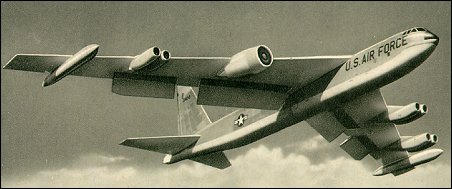 |
Boeing B-52 Stratofortress1954 |  |
| BOMBER | Virtual Aircraft Museum / USA / Boeing |
 |
Most post-World War II bombers evolved from military requirements issued in the early or mid-forties, but none were produced as initially envisioned. Geopolitical factors accounted for the programs; the military threat, varying in degrees of intensity through the years, never ceased to exist. While these factors justified the development of new weapons, technology dictated their eventual configurations. Strategic concepts fell in between, influenced by circumstances as well as the state-of-the-art. Thus the B-36, earmarked in 1941 as a long-range bomber, capable of bearing heavy loads of conventional bombs, matured as the first long-range atomic carrier. The impact of technology was far more spectacular in the case of the B-52, affecting the development of one of history's most successful weapon systems, and the concepts which spelled the long-lasting bomber's many forms of employment. As called for in 1945, the B-52 was to have an operating radius of 4,340 nautical miles, a speed of 260 knots at altitude of 43,000 feet, and a bombload capacity of 10,000 pounds. Although jet propulsion had already been adopted for the smaller B-45 and B-47 then under development, the high fuel consumption associated with jet engines ruled against their use in long-range aircraft. But what was true in 1945, no longer applied several years later. After floundering through a series of changing requirements and revised studies, the B-52 project became active in 1948. Air Force officials decided that progress in the development of turbojets should make it possible to equip the new long-range bomber with such engines. The decision, however, was not unanimous. Money was short, B-52 substitutes were proposed, and it took the deteriorating international situation caused by the Korean conflict to ensure production of the jet-powered B-52-the initial procurement contract being signed in February 1951. While technological improvements received top priority when new weapons were designed, untried technology was a tricky business. Hovering over the B-52 weapon system was the specter of the B-47's initial deficiencies. As a result, the B-52 was designed, built, and developed as an integrated package. Components and parts were thoroughly tested before being installed in the new bomber. Changes were integrated on the production lines, giving birth to new models in the series, a fairly common occurrence. Yet, in contrast to the usual pattern, B-52 testing only suggested improvements, and at no time uncovered serious flaws in any of the aircraft. In fact, Maj. Gen. Albert Boyd, Commander of the Wright Air Development Center, and one of the Air Force's foremost test pilots, said that the B-52's first true production model was the finest airplane yet built. Initially flown in December 1954, the B-52's performance was truly impressive. The new bomber could reach a speed of 546 knots, twice more than called for in 1945, and could carry a load of 43,000 pounds, an increase of about 30,000 pounds. Still, most of the early B-52s were phased out by 1970, due to Secretary of Defense Robert S. McNamara's mid-sixties decision to decrease the strategic bomber force. However, the later B-52G and H-models, and even some of the earlier B-52Ds, were expected to see unrestricted service into the 1980s. By mid-1973, the B-52s had already compiled impressive records. Many of the aircraft had played important roles during the Vietnam War. Modified B-52Ds, referred to as Big Belly, dropped aerial mines in the North Vietnamese harbors and river inlets in May 1972. In December of the same year, B-52Ds and B-52Gs began to bomb military targets in the Hanoi and Haiphong areas of North Vietnam, where they encountered the most awesome defenses. Although the B-52s were often used for purposes they had not been intended to fulfill, after decades of hard work they remained one of the Strategic Air Command's best assets.

|  COMPANY PROFILE | |||||||||||||||||||||||||||||||||||||||||||||||||||||||||||||||
 |

|

